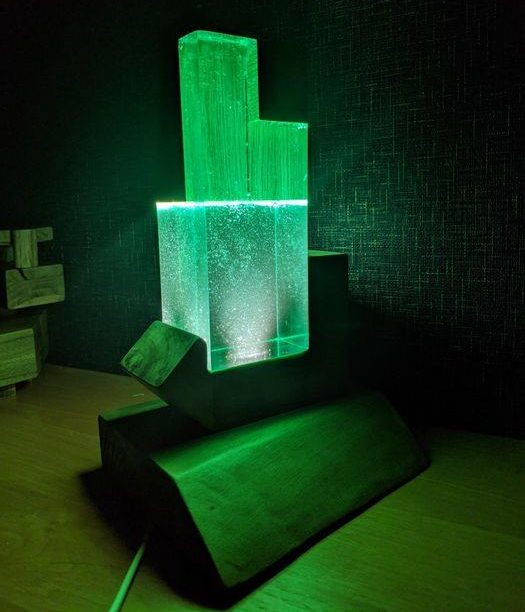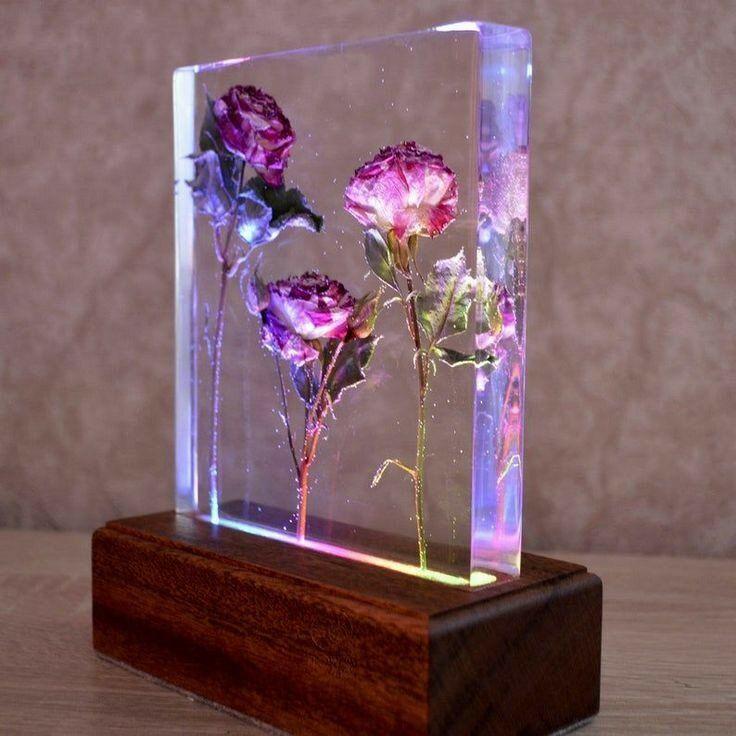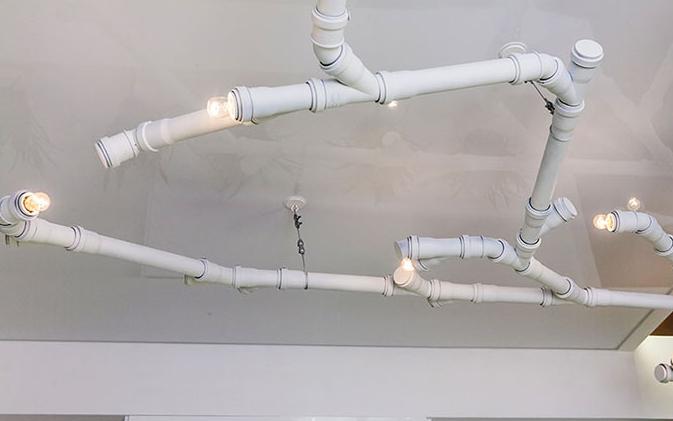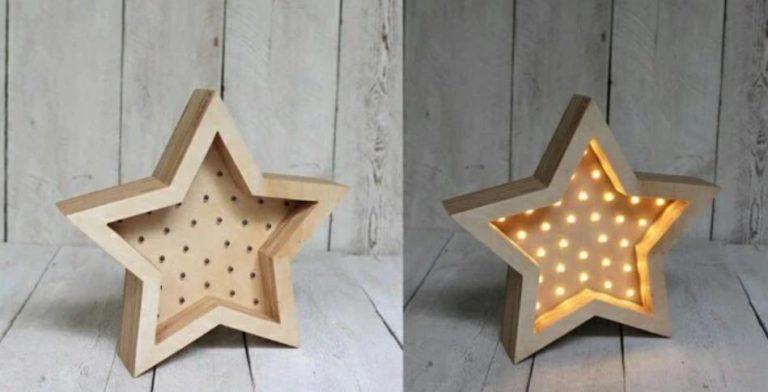Interesting fixtures made of wood and epoxy resin
One of the unconventional and trendy solutions in lighting is a lamp made of epoxy resin. With this material, you can get not just a lamp, but a true art object. The article will tell you how to make a lamp from epoxy with your own hands. As a supplement - tips and useful tips.
Advantages of lighting fixtures made of epoxy and wood
From epoxy you can get a light fixture of extraordinary beauty, in which a miniature cosmos seems to be frozen. The material gives enormous scope for creativity. Frozen resin is similar to colored glass, but unlike it, completely safe and unbreakable. A number of advantages have a lamp made of epoxy:
- original appearance;
- The resin adheres well to all surfaces;
- reasonable price and environmental friendliness of materials;
- long shelf life;
- soft diffused light from the lamp;
- the luminaires fit any room design;
- high resistance to mechanical stress.
Design options
A brief look at popular varieties of fixtures made from wood and epoxy.
- Floor. Designed to illuminate floors and stairs in the house. In addition to the visual effect, they provide a practical benefit by helping you walk safely in the dark.A floor lamp helps you get around in a dark room.
- The sconce. A sconce often uses an outlandish base, made of epoxy, on which an ordinary lampshade is hung. It turns out a soft diffused light of unusual shades. Another option is minimalist sconces with white or black resin lanterns.
- Nightlights. An epoxy lamp will adorn a table or nightstand in any bedroom. Here you can show your imagination to your heart's content. The night sky, the forest will be embodied in resin. One of the most beautiful lights is a round epoxy moon.Refined night light made of epoxy in the form of the moon.
- Individual element decor. Individual parts of the interior will add originality to the room decorated with resin and wood illumination. For example, they can be decorated with lamps with flowers, leaves, tree bark, moss inside.Flowers inside an epoxy lamp
- Painting in the lamp. Some craftsmen even manage to capture works of art in epoxy. Most often these are natural landscapes. Such masterpieces are installed on the walls or placed on the table.
- Floor lighting. With the help of epoxy you can do floor lighting .. In particular, this method is good for hallways and bathrooms.
- Furniture decor. Romantic atmosphere will create illuminated furniture made of epoxy resin: tables, bedside tables, chairs. Beautiful and functional at the same time.Beautiful table made of epoxy.
Step by step instructions and tips
If there is an intention to make a lamp from epoxy with your own hands, it is worth approaching it seriously. Texts, YouTube videos, and personal experiences of acquaintances all come in handy. It is better to have a bag full of information, as well as a preliminary sketch of the future crafts. Now, a step by step algorithm of work.
What tools are needed?
To make lantern with their own hands You will need a list of such improvised means:
- a flat bar of wood (more about him a little further);
- epoxy;
- hardener for the resin;
- coloring pigments, pastes;
- liquid for impregnation and wood treatment;
- milling machine;
- chisel;
- sanding tapes with different grits;
- drill with different types of drill bits;
- sealant;
- acrylic for the pouring box;
- socket and LED lamp of small power (up to 3 watts).
Additionally, you'll need some small things:
- a pencil;
- ruler;
- duct tape;
- brush;
- disposable cups.
Choosing a bar for the base
Barely the most important thing in making an epoxy light fixture is to choose a quality base. This should be an even, solid piece of wood (preferably oak), without breaks and cracks. It can, of course, additionally sanded, give a beautiful shape, but the bar itself must initially be of high quality. Standard length - 25-30 cm, cross section - up to 100 mm.
Preparing the base
Next, you need to decide which side of the bar will go under the base, and which should be given to the "payoff" of epoxy. Under the ruler, two parallel lines are drawn across the bar, and then on one of them you need to draw an arc-shaped line. It will become a reference point for drilling the bar with a drill. Then, using a chisel, it is divided in two.

Next you need to drill on both sides of the bar in the center hole for the LED. It should be through: only so the light will enter the epoxy "half". It is worth measuring the diameter of the socket, the lamp, and make the width of the hole a little larger.
It is necessary to protect the lamp holder from the risk of ingress of resin. To do this, a round piece equal in diameter to the upper hole is cut from a transparent non-solid material (plastic, plexiglass) and placed in the hole on the resin side.
Pouring box
The next step is to pour the epoxy resin. It is necessary to pour directly on the base. To prevent the material from flowing, it must be "held back" with a special temporary box. An acrylic sheet is used to make it. All sides should be slightly longer than the corresponding side of the base. The box is fastened into a single structure with scotch tape. The gaps between the walls of the box and the base should be carefully plugged with sealant.
Pouring
Before pouring, epoxy resin must be mixed with dye and hardener in strictly defined proportions. They are usually written on the packaging.
It is recommended to pour the epoxy in several layers. Each layer takes at least 2-3 hours to dry, or better yet, leave it to dry overnight. So with each layer.
Recommended to watch: Mistakes when working with epoxy.
Drying
If additional decorations are planned, they must be added immediately, otherwise the mixture will dry out. Full curing of the epoxy will take at least a day. After checking the quality, the casting box and sealant fragments are removed.
Grinding and polishing the resin
The cured epoxy has to be carefully sanded. At first, you can use nozzles with coarse grit (80, 100), but as you progress in the work, you should gradually increase the grit. At the last stage of sanding, you will need tapes with a grain size of 2000 and above.
Sanding epoxy gives it a matte finish. If you want gloss, it is also not difficult to achieve. You need a felt wheel, as well as a special paste for polishing plastic surfaces.
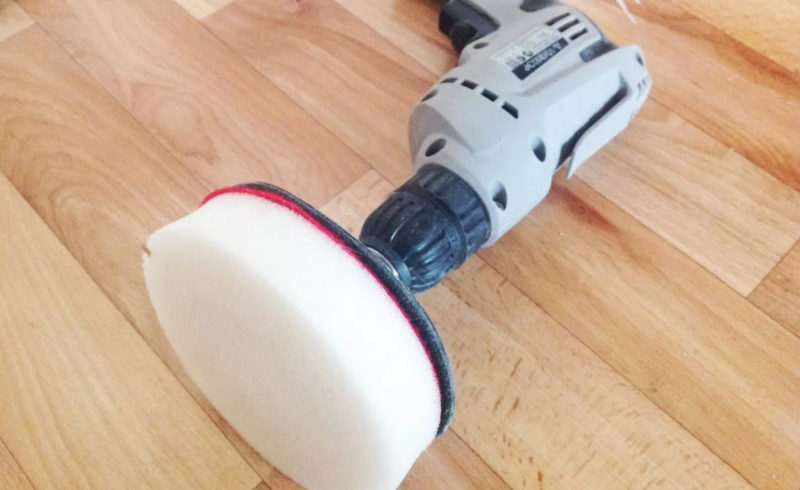
Finishing the base
Do not forget about the treatment of the base. This will give the wooden part of the lamp a shiny appearance. Various varnishes or oils with flame retardant properties are suitable for treatment.
Wiring
It is necessary to drill a hole at the bottom, in which is placed a cable with a socket and LED bulb. The socket must be secured securely with a clamp or clamp. Finally, check whether the "freshly assembled" lantern works.
Additional decor
It is better to put the wooden base on low feet of foam rubber, so that the surface on which the lamp will stand, and the wood did not conflict. Another way is to "dress" the base completely in a special stand, for example, made of plastic.
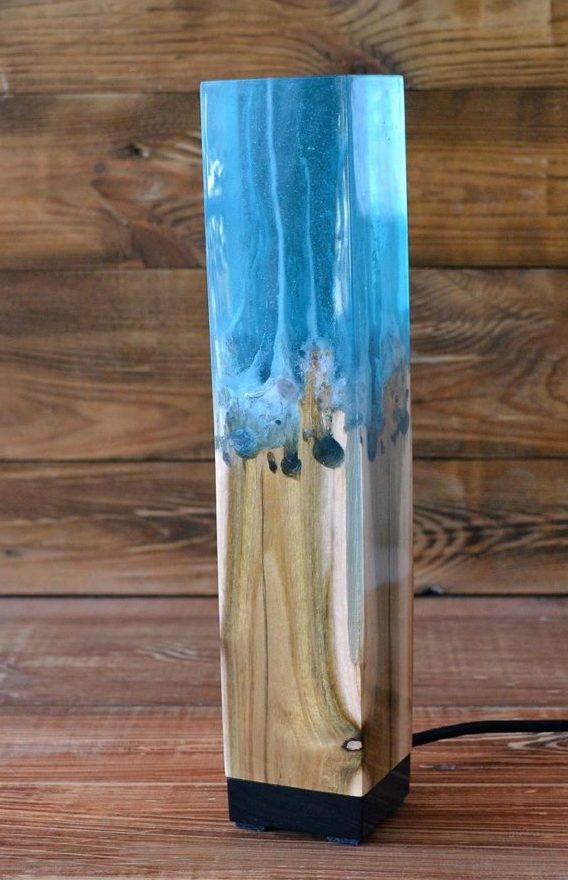
The epoxy part, on the other hand, can be turned into a true masterpiece by adding:
- decorative wood chips;
- small transparent stones, beads;
- dried leaves, berries;
- fluorescent pigments.
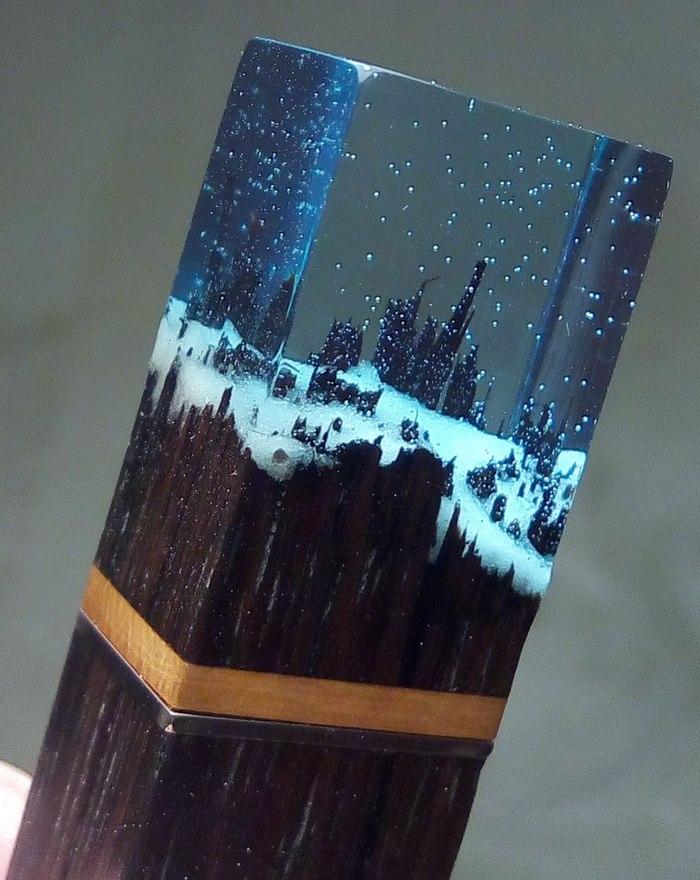
Recommendations for making and using
A few important recommendations before you get to work:
- Only jewel or decorative epoxy is suitable.
- All work should be done on a flat surface and in a well ventilated room.
- Be sure to protect your hands with rubber gloves and your face with a respirator or mask and goggles.
- After completing the work, the room should be ventilated for several hours, the longer the better.
There are no special wisdoms in the operation of epoxy lamps. The only, but very important caveat: You should not allow the polymer to overheat. To do this, you should use a low-power LED lamp.
Video lesson: Making a night light fixture out of oak and epoxy resin.
A few little tricks
To conclude, a couple of interesting solutions and tips that will come in handy when sculpting an epoxy lamp:
- You can tuck some foil underneath the hole for the bulb. It will reduce the risk of overheating the base.
- A drill will help stir the epoxy well. However, this will cause the polymer to start bubbling. If the bubbles are not in the design, you can get rid of them in a simple way. The container with the resin is heated in a water bath, and soon the air is gone. Those bubbles that remain are easily removed by piercing with an ordinary toothpick. The temperature of heating - no more than 50 degrees.
- Pouring the resin in layers will create exciting transitions. The main thing is to let each layer harden well.
